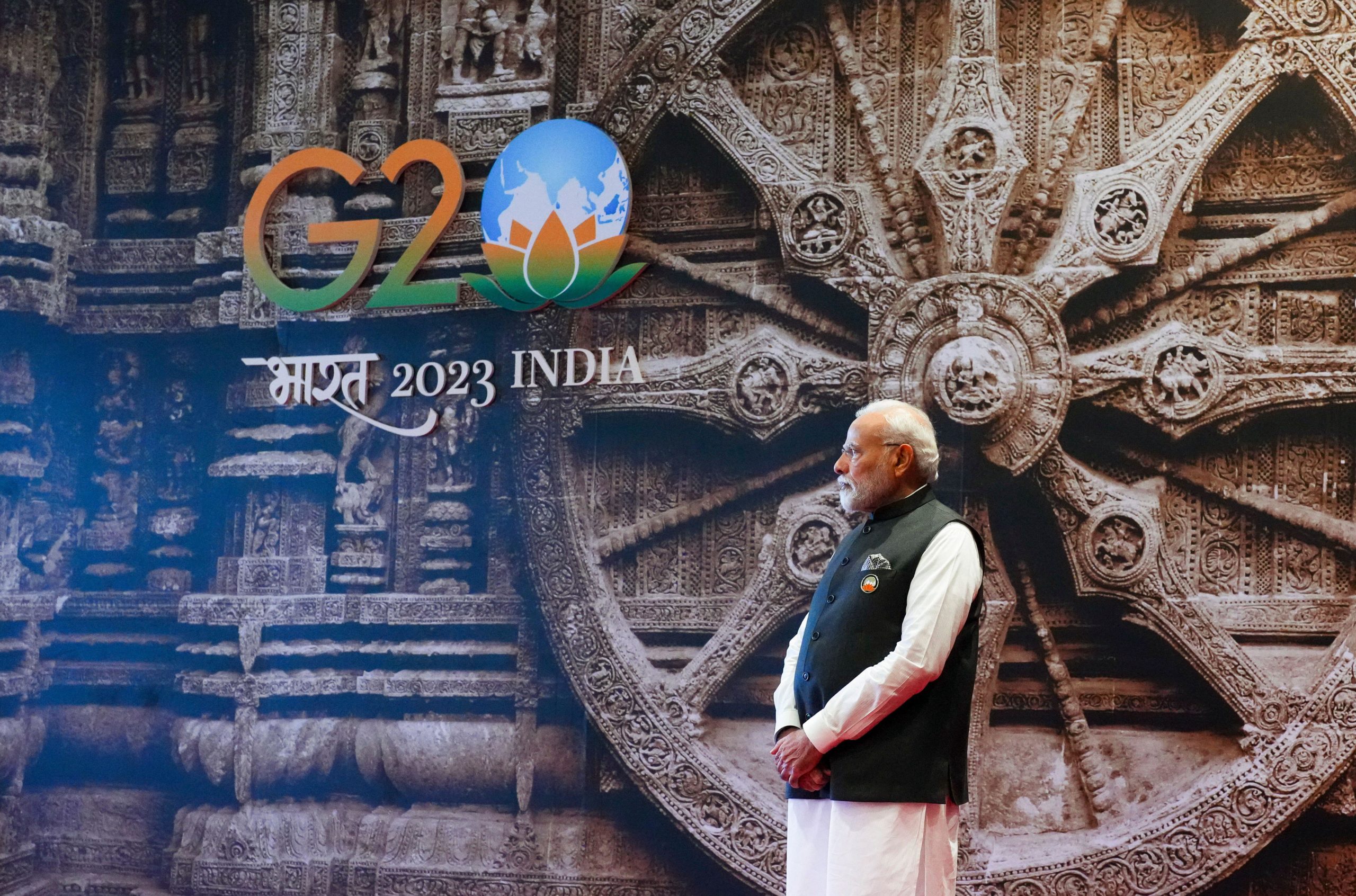The Third Pole 14 September 2023

Indian prime minister Narendra Modi waits to officially welcome participants to the G20 Summit in New Delhi, India on Saturday, 9 September, 2023 (Image: Alamy)
Ahead of the G20 leaders summit in New Delhi, Indian prime minister Narendra Modi published an article laying out his goals and priorities during India’s presidency of the G20, which runs through to December. A sizable portion of his essay focused on climate change.
“We believe there is a need to move away from a purely restrictive attitude of what should not be done, to a more constructive attitude focusing on what can be done to fight climate change,” he wrote.
This emphasis on climate change makes sense. It’s the very type of pressing global challenge that the G20 was created to tackle. It poses a major threat to the Global South, and Modi is keen to use the G20 to help address that region’s biggest challenges. Fighting climate change is also a top domestic and foreign policy priority for India and most other G20 members, and it’s not a fraught geopolitical issue like the Ukraine war. Furthermore, since last year’s UN climate summit, which produced an agreement to establish a loss and damage fund for climate-vulnerable states, a new global norm has emerged around the idea of wealthier countries banding together to deliver climate-related assistance to the Global South.
Not surprisingly, climate change is a prime focus of the summit’s joint statement, published on Saturday. The “Green Development Pact for a Sustainable Future” section runs to eight pages – longer than any other topic – and covers subjects ranging from clean energy transitions and emissions cuts to climate finance and plastic pollution.
And yet, the Delhi Declaration still falls short on climate. It features extensive pledges to fight climate change, but most don’t offer specific targets or timeframes. Additionally, the document doesn’t set specific mitigation goals and targets for G20 countries themselves. Rather, the focus is more on contributing to global mitigation efforts: “We reiterate our commitment to achieve global net zero GHG emissions/carbon neutrality” and “Will pursue and encourage efforts to triple renewable energy capacity globally through existing targets and policies” (emphases mine).
There is little doubt that the varying national situations of member states make it hard to set common goals and targets for pursuit at home. But that doesn’t have to prevent the G20 from, say, deciding on separate common emissions reduction targets for developed and developing members.
The inconvenient truth is that, despite genuine commitments to promote a greener planet, so many G20 members are still locked into old and dirty energy habits. This lessens the likelihood of upholding pledges on curbing emissions, and helps explain why many of the Delhi Declaration’s climate commitments are vague.
Last year, G20 members spent a record amount on fossil fuels. According to energy think tank Ember, multiple G20 countries saw major rises in per capita emissions over the past seven years, including Indonesia (56%), Turkiye (41%), China (30%), and India (29%). Many G20 members, most notably China and India, remain heavily reliant on coal, though Australia and South Korea were the top two G20 coal power polluters in 2022, according to Ember. They emitted more than triple the global average.
To be sure, many G20 countries have not only pledged to reduce emissions, but also taken concrete steps toward that goal. However, a continued dependence on dirty fuels has undermined that goal, and weakened incentives within the G20 to take more robust steps to tackle climate change.
India, the current G20 president and the world’s third-largest energy consumer, offers a sobering case study. At the 2021 UN climate summit in Glasgow, Modi pledged to make India a net zero nation by 2070. Since then, his government and India’s private sector have implemented a flurry of policies to kickstart India’s carbon transition. In the last six months alone, major Indian conglomerates have pledged new clean energy investments, and the power ministry announced it will accept bids for 50 gigawatts of clean energy capacity for the next five years. New Delhi has committed billions in assistance to top state-owned hydrocarbon firms to support their clean energy transitions. The government has also pledged not to build new coal power plants for five years.
Additionally, New Delhi has signalled an intention to diversify its fledgling renewable energy mix. It has proposed a USD 2.6 billion subsidy package for the next seven years for companies that produce electricity batteries, to ramp up solar energy storage capacity, but it is also offering subsidies to encourage production of green hydrogen. The government has committed USD 2 billion to develop its green hydrogen sector, and it is also focused on green ammonia, a derivate of green hydrogen.
There’s nothing lost by setting out pledges with specific targets and timeframes, instead of general commitments. That this didn’t happen likely reflects many G20 members’ inability to uphold such pledges.
But dirty habits die hard. Coal constitutes 75% of India’s electricity and 70% of total energy production. Coal production has increased by nearly 50% over the last nine years. This past year, state-owned Coal India, which accounts for 80% of India’s coal output, surpassed its annual production targets for the first time in 17 years. And it’s full speed ahead. In January, 22 companies submitted 35 bids to extract coal from 18 different coal mines across the country. In March, India’s coal minister predicted that by 2026, India will be so flush with coal it will be able to start exporting it.
This isn’t just a story about coal. Domestic petroleum production increased nearly 4%, and natural gas more than 8%, between July 2022 and 2023.
Additionally, for all the talk of Indian companies transitioning to renewables, that won’t be easy. India’s Reserve Bank recently warned that India’s powerful industrial and agricultural sectors, which contribute major shares of India’s total emissions, could be obstacles to a greener economy. Additionally, with India’s carbon tax rate among the world’s lowest, many firms could simply swallow the costs and not ramp up renewables.
G20 joint statements aren’t binding. There’s nothing lost by setting out pledges with specific targets and timeframes, instead of general commitments. That this didn’t happen likely reflects many G20 members’ inability to uphold such pledges, and their continued attachment to the very polluting policies that contributed to climate change in the first place.

